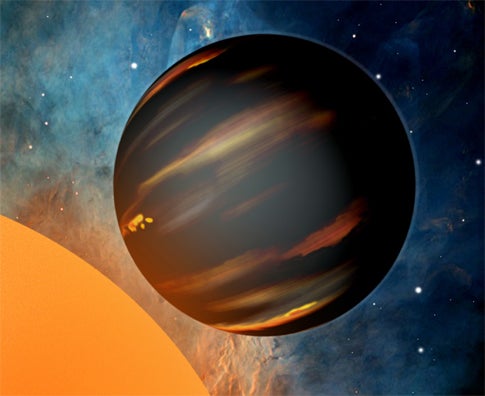A planet orbiting a giant red star has been discovered by an astronomy team led by Penn State’s Alex Wolszczan. The discovery is helping astronomers understand what will happen to the planets in our solar system when our Sun becomes a red-giant star. The star is 2 times more massive and 10 times larger than the Sun. The newly-discovered planet circles the giant star every 360 days and is located about 300 light years from Earth in the constellation Perseus.
The discovery resulted from an effort to find Jupiter-mass planets around far-away red-giant stars the research team began three years ago. “After astronomers have spent more than 10 years searching for planets around Sun-like stars and discovering over 250 planets elsewhere in our galactic neighborhood, we still do not know whether our solar system’s properties — including life-supporting conditions on our planet — are typical or exceptional among solar systems throughout the galaxy,” Wolszczan says. “The picture for now, based on the searches for planets around stars like our Sun, is that our planetary system appears to be unusual in a number of ways.”
“This planet is the first one discovered by Penn State astronomers with the Hobby-Eberly Telescope, and it is in one of the most distant of the ten published solar systems discovered around red-giant stars,” says Lawrence Ramsey, a member of the discovery team and head of the Department of Astronomy and Astrophysics at Penn State. Ramsey is a leader in the conception, design, construction, and operation of the Hobby-Eberly Telescope.
Astronomers now are searching for planets using different strategies. They hope to detect extraterrestrial life, and discover all possible kinds of solar systems and learn how they form. Wolszczan — who first discovered planets outside our solar system in 1992 — used one of these new strategies: searching for planets around giant stars.
“We have compiled a catalog of nearly a thousand giant stars that are candidates for hosting solar systems,” Wolszczan says. Because the method for discovering planets involves repeated measurements of their gravitational effect on the star they circle, and because planets around red giants can take years to make one orbit around the star, the research team is just now beginning to reap discoveries from years of systematic observations. “This planet is just the first of a number of planet discoveries that this research program is likely to produce.”
The research is a collaboration between astronomers at Penn State, Nicholas Copernicus University in Poland, the McDonald Observatory, and the California Institute of Technology.
Studying solar systems that include red-giant stars helps astronomers understand more about the future of our own solar system. “Our Sun probably will make the Earth unhabitable in about 2 billion years because it will get hotter and hotter as it evolves on its way to becoming a red giant about 5 billion years from now,” Wolszczan says. As the star swells up, it affects the orbits of its planets and the dynamics of the planetary system, causing changes such as orbit crossings, planet collisions, and new-planet formation. “When our Sun becomes a red giant, Earth and the other inner planets very likely will dive into it and disappear,” Wolszczan says.
Another motivation for studying red-giant stars is to understand how their habitable zones move farther out as the star’s radiating surface becomes bigger. Based on how long it took for life to develop on Earth, scientists speculate that there is more than enough time during a star’s giant phase for life to start somewhere in evolving habitable zones.
Astronomers discover planets by observing candidate stars, repeatedly measuring their space velocity using the Doppler effect — the changes in the star’s light spectrum that result from its being pulled alternately toward and away from Earth by the gravity of an orbiting planet. “When we detect a significant difference in a star’s velocity over a month or two, we then start observing that star more frequently,” Wolszczan says. “The velocity of the star changed by about 50 meters per second (100 miles per hour) between our first and second observations, so we observed that star more frequently and we found a clearly repeatable effect, indicating the presence of a planet.”
By searching for planets around giant stars, scientists also learn about the formation of planets around stars more massive than our Sun. Because massive stars are so hot when they are in the phase of life of our Sun, astronomers have not been able to detect enough of their spectral lines to use the Doppler-spectroscopy method of finding planets. However, these stars become cooler as they evolve into giants, at which point the spectral-line observations become possible.
Another reason astronomers search for planets around different stars at different stages of stellar evolution is to find how planetary systems change and ultimately die when their stars become red giants.
“We really are at the very beginning of this effort and it is going to take time to get a consistent picture of planetary formation and evolution,” Wolszczan says. “The more we learn, the greater the chance will be that sooner or later we will discover how ordinary or extraordinary is our home — the Earth’s solar system.”










